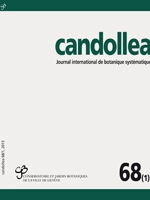Udayan, P. S., Regy Yohannan, M. S. Devipriya, V. Devipriya & A. K. Pradeep (2013). Salacia vellaniana Udayan, Yohannan & Pradeep (Celastraceae), a new species from India. Candollea 68: 147–149. In English, English and French abstracts.
Salacia vellaniana Udayan, Yohannan & Pradeep (Celastraceae), a new species from South India, is described and illustrated. It is also compared with the related Salacia macrosperma Wight.
Introduction
The genus Salacia L. (Celastraceae) consists of ca. 200 species distributed in tropical America, Africa and Asian countries (Mabberley, 2005). In India it is represented by 21 species. Among them 15 species are known to occur in Peninsular India (Ramamurthy & Naithani, 2000), of which 8 species were recorded from Kerala (Sasidharan, 2004; Ramamurthy & Venu, 2005; Nayar & al., 2006). During intensive botanical studies along the Western Ghats of Kerala state in South India, the authors collected one interesting species of this genus from Vellanipacha forest of Thrissur district, Kerala, South India. Critical studies revealed this to be a new species of Salacia and hence described here with an illustration.
Salacia vellaniana Udayan, Yohannan & Pradeep, spec. nova (Fig. 1).
Typus: India. Kerala: Thrissur district, Vellanipacha, 540 m, in semi-evergreen forests, 26.II.2011, Udayan S005 (holo-: CALI; iso-: MH, SKC, SNCH).
Salaciae macrocarpae affinis a qua imprimis differt ramulis junioribus laevigatis rubriginosis, foliis minoribus, oblongis, coriaceis, integris, petiolis brevibus, 4–6 mm longis, floribus paucioribus (1–8), cymis, corollae lobis et disco flavovirentibus, antheris 3–4, fructibus echinulatis pallide rubro-aurantiacis.
Straggling shrubs; young branchlets smooth, brownish. Leaves oblong, 6.3-11.1 × 2.6-3.6 cm, apex acuminate, base cuneate or attenuate coriaceous, margin entire, venation semicraspedodromous; petiole 0.4–0.6 cm long. Flowers 1–8, cauliflorous cyme in simple fascicles from axillary or extra-axillary branches; pedicel 0.5 cm long. Calyx lobes 5, triangular ovate, brown, ca. 0.5 cm long, much shorter than the petals, margin fimbriate. Corolla lobes 5, oblong-lanceolate, 0.15 × 0.2 cm, green with a tinge of yellow towards the upper margins. Disc green turning creamy yellow, 0.1 × 0.2 cm, conical, tapering towards style. Anthers 3, rarely 4, discoid, creamy-white with a brown tinge; filaments slightly tri-radiate, creamy-white when young, but yellow with orange tinge later. Ovary superior, 3-loculed; ovules 1 in each locule; stigma simple umbonate, pale green. Fruits globose or obovate, 2.5-3.5 × 1.5-2.5 cm, tuberculate, pale reddish-orange. Seeds 3, ellipsoid, slightly angular, immersed in pulp, 1-1.5 × 0.5-1.2 cm.
Distribution and habitats. — Known only from the type locality, Vellanipacha in Thrissur district of Kerala. Salacia vellaniana is restricted to semi-evergreen forests at an altitude of 540–550 m. It is rather rare and sparsely distributed along the hill tract with trees species such as Diospyros crumenata Thwaites (Ebenaceae), Drypetes oblongifolia (Bedd.) Airy Shaw (Euphorbiaceae) and Hunteria zeylanica Thwaites (Apocynaceae). Two plants have been located in the study area and, despite frequent searches along the hills and neighborhoods, no other individuals of this species have been found.
Etymology. — The species is named after Vellanipacha, one of the floristically rich regions along the Western Ghats of southern India.
Flowering & fruiting. — February-July.
Taxonomical notes. — This straggling shrub is allied to S. macrosperma Wight from which it differs particularly by the smooth brownish young branchlets, smaller, oblong, coriaceous entire leaves, vs larger, narrow oblong serrated leaves, short, 4–6 mm long petioles vs longer petioles (10–15 mm); few (1–8) flowered cymes, vs many (22–30) flowered cymes; pale yellow corolla lobes and disc, green corolla lobes green turning brown towards margins; disc green turning creamy yellow later vs green with only a slight tinge of yellow; 3–4 anthers vs 3 anthers and pale reddish-orange echinulate fruits, vs larger dark reddish smooth fruits.
Other specimen examined. — India. Kerala: Thrissur district, Vellanipacha, 540 m, 15.I.2011, in semi-evergreen forests, Udayan 0S002 (SKC, SNC, CALI).
Acknowledgements
The authors are thankful to Dr. V. P. Prasad, IBLO & Scientist «C» at K, for his help and opinion on the identity of the species, as well as Dr. M. Sanjappa, Director of BSI, Kolkatta, Dr. G. V. S. Murthy, Joint Director at BSI, and Dr. N. Sasidharan, Scientist at KFRI. They thank also the Kerala State Council for Science, Technology & Environment (KSCSTE), Thiruvanathapuram, for financial support, as well as Mr. Umesh M., Project Fellow, S. N. College, Kollam for neat illustrations, the authorities of Kerala State Forest Department for granting permission and their generous help during field visits, Mr. Satheesh George, Scientist, Arya Vaidya Sala, Kottakkal and Mr. A. J. Robi, Project Fellow, for this KSCSTE Project at KFRI for assistance in the field.






